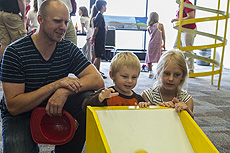DASTOW 2015 scheduled for Friday, June 26
 |
Register now for Daughters and Sons to Work Day activities. Photo: Cindy Arnold |
School-age children of Fermilab employees, users and contractors can see physics up close on Friday, June 26, when they visit Fermilab for Daughters and Sons to Work (DASTOW) day.
Enjoy activities such as a visit to the Fermilab Fire Department, Physics Fun on 15, Remote Operations Center West open house and lunch in the Wilson Hall atrium (with Mr. Freeze). Lederman Science Center will be open and a bus will be run between Wilson Hall and the Center from 10:30 a.m. to noon (or if the weather is nice, feel free to walk!).
New this year are two programs aimed at middle and high school students: Exploring Dark Energy and Behind the Scenes at Fermilab. For a complete schedule of the day's events, visit the DASTOW website.
Advance registration is required for:
Physics Fun on 15
Geared toward kids 10 and under, Physics Fun on 15 will feature hands-on science activities offered by Fermilab's Education Office on the 15th floor of Wilson Hall. You will need to register online for this activity; the deadline is June 22.
Advance registration is recommended for:
Exploring Dark Energy, 10:45 to 11:15 a.m., One West
The universe is expanding faster and faster, and scientists believe a mysterious force called dark energy is behind it. Fermilab astrophysicist Brian Nord will talk about that force and our attempts to understand it with the Dark Energy Camera. Registering online for this activity is recommended. This is geared toward middle and high school students, but everyone is welcome.
Behind the Scenes at Fermilab, 11:30 a.m. to noon, One West
Middle- and high-school-age kids will have the opportunity to meet and hear from Fermilab employees about their interesting jobs at the lab. There will be plenty of time for questions! Registering online for this activity is recommended. This is geared toward middle and high school students, but everyone is welcome.
Exposing children to the workplace is an excellent way to show them the value of education, help them understand what their parents or relatives do at work, and get them thinking about future career options.
DASTOW is scheduled on a Friday from 8:30 a.m. until 12:30 p.m., allowing time in the afternoon for children to observe their parents while at work. If you choose instead to take vacation time in the afternoon to extend your weekend, please obtain your supervisor's approval in advance.
|